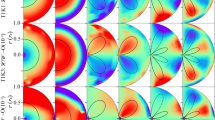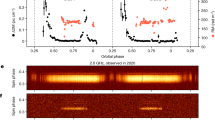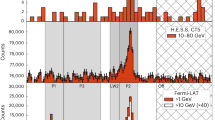Abstract
The measured period derivative1–3 for the millisecond pulsar PSR1937 + 214 is Ṗ ≃ 1.05×10−19, whereas the present upper limit5 for PSR1953 + 296 is Ṗ<4.2×10−17. For electromagnetic braking, the combination of rapid rotation with such small period derivatives requires a small (∼108 G) magnetic field. A natural association between rapid rotation and small magnetic field is provided by accretion spin-up scenarios7–9. Here we address the analogous problem for gravitational radiation. Balancing gravitational radiation power against the rate of rotational energy loss, we find that if the effective triaxiality εeff exceeds εmax∼10−9, gravitational radiation alone would spin a millisecond pulsar down at a faster rate than the observed Ṗ. We show that εeff<<εmax, so that gravitational radiation is not likely to play a major role in the evolution of millisecond pulsars even in the absence of damping. Damping times for precession of the solid crust are estimated to be <2×l03 yr.
This is a preview of subscription content, access via your institution
Access options
Subscribe to this journal
Receive 51 print issues and online access
$199.00 per year
only $3.90 per issue
Buy this article
- Purchase on SpringerLink
- Instant access to full article PDF
Prices may be subject to local taxes which are calculated during checkout
Similar content being viewed by others
References
Ashworth, M., Lyne, A. G. & Smith, F. G. Nature 301, 313–314 (1983).
Backer, D. C., Kulkarni, R. S. & Taylor, J. H. Nature 301, 314–315 (1983).
Backer, D. C. in Proc. Workshop on Millisecond Pulsars (eds Reynolds, S. & Stinebring, D.) 3–8 (NRAO, Greenbank, West Virginia, 1984).
Backer, D. C., Kulkarni, R. S., Heiles, C., Davis, M. M. & Goss, W. M. Nature 300, 615–618 (1982).
Boriakoff, V., Buccheri, R., Fauci, F., Turner, K. & Davis, M. in Proc. Workshop on Millisecond Pulsars (eds Reynolds, S. & Stinebring, D.) 24–29 (NRAO, Greenbank, West Virginia, 1984).
Boriakoff, V., Buccheri, R. & Fauci, F. Nature 304, 417–419 (1983).
Alpar, M. A., Cheng, A. F., Ruderman, M. A. & Shaham, J. Nature 300, 728–730 (1982).
Radhakrishnan, V. & Srinivasan, G. Curr. Sci. 51, 1096–1099 (1982).
Fabian, A. C., Pringle, J. E., Verbunt, F. & Wade, K. A. Nature 301, 222–223 (1983).
Pines, D. & Shaham, J. Phys. Earth planet. Inter. 6, 103–115 (1972).
Wagoner, R. Astrophys J. 278, 345–348 (1984).
Friedman, J. L. Phys. Rev. Lett. 51, 11–14 (1983).
Landau, L. D. & Lifshitz, E. M. Mechanics Ch. 6 (Pergamon, Oxford, 1976).
Weinberg, S. Gravitation and Cosmology Ch. 10 (Wiley, New York, 1972).
Shapiro, S. L. & Teukolsky, S. A. Black Holes, White Dwarfs and Neutron Stars Ch. 16 (Wiley-Interscience, New York, 1983).
Pandharipande, V. R., Pines, D. & Smith, R. A. Astrophys. J. 208, 550–566 (1976).
Ruderman, M. A. Nature phys. Sci. 223, 597–598 (1969).
Baym, G. & Pines, D. Ann. Phys. 66, 816–835 (1971).
Smoluchowski, R. Phys. Rev. Lett. 24, 923–925 (1970).
Pines, D. & Shaham, J. Nature phys. Sci. 235, 43–49 (1972).
Shaham, J. Astrophys. J. 214, 251–260 (1977).
Alpar, M. A., Anderson, P. W., Pines, D. & Shaham, J. Astrophys. J. 276, 325–334 (1984).
Pines, D. & Alpar, M. A. Proc. Workshop on Millisecond Pulsars (eds Reynolds, S. & Stinebring, D.) 161–169 (NRAO, Greenbank, 1984).
Bondi, H. & Gold, T. Mon. Not. R. astr. Soc. 115, 41–46 (1955).
Pines, D. & Shaham, J. Nature 248, 483–486 (1974).
Alpar, M. A., Langer, S. A. & Sauls, J. A. Astrophys. J. 282, 533–541 (1984).
Author information
Authors and Affiliations
Rights and permissions
About this article
Cite this article
Alpar, M., Pines, D. Gravitational radiation from a solid-crust neutron star. Nature 314, 334–336 (1985). https://doi.org/10.1038/314334a0
Received:
Accepted:
Issue date:
DOI: https://doi.org/10.1038/314334a0
This article is cited by
-
Wie wichtig ist die Gravitationswellen-Astronomie?
Naturwissenschaften (1986)



